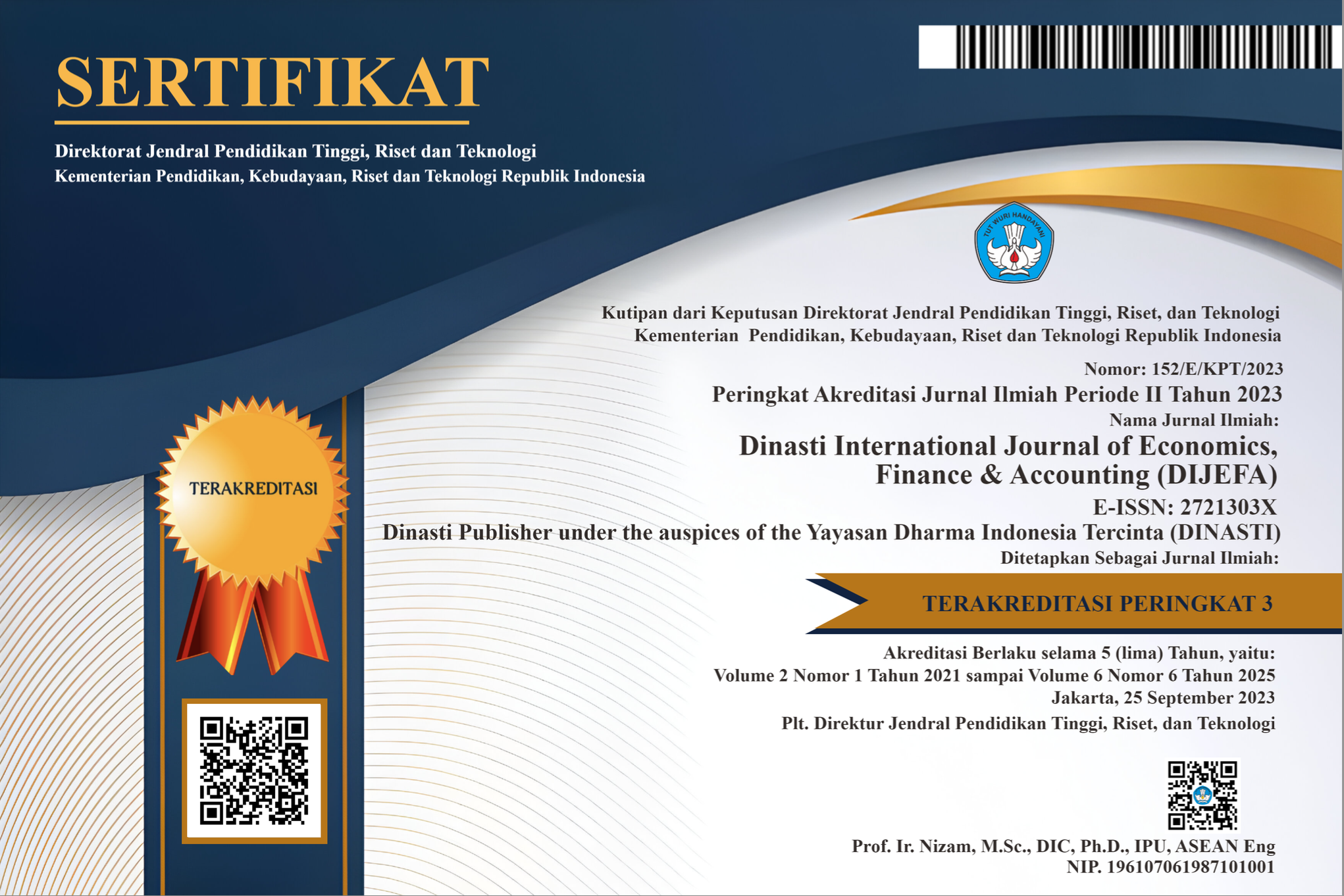The Effect Of Per Capita Income, Bi Rates And Consumer Price Index On The Demand For Electronic Money In Indonesia 2009-2022
DOI:
https://doi.org/10.38035/dijefa.v5i4.3337Keywords:
per capita income, bi-rate, consumer price index, electronic moneyAbstract
This study aims to analyze the effect of per capita income, Bank Indonesia (BI) interest rates, and the consumer price index on the demand for electronic money in Indonesia during the period 2009-2022. In an increasingly developing digital economy era, financial technology (FinTech) innovations play a crucial role in facilitating financial transactions and fostering a cashless society. This study highlights macroeconomic variables that are considered to have a significant impact on the adoption of electronic money in Indonesia.The data used in this study consists of annual data obtained from official sources such as Bank Indonesia and the Central Bureau of Statistics. The analysis method used is multiple linear regression to measure the effect of each independent variable on the dependent variable. Before performing the regression analysis, classical assumption tests were conducted to ensure that the data met the classical linear regression requirements, including tests for normality, multicollinearity, autocorrelation, and heteroscedasticity.The results of the study indicate that per capita income has a positive and significant effect on the demand for electronic money. This finding suggests that an increase in per capita income encourages greater use of electronic money as a means of payment. BI interest rates were also found to have a significant but negative effect on the demand for electronic money, indicating that higher interest rates tend to reduce the use of electronic money. Conversely, the consumer price index was found to have a positive but not significant effect on the demand for electronic money, meaning that fluctuations in consumer prices do not have a substantial impact on the use of electronic money.
References
Aini, Butra, H., & Dkk. (2016). Analisis Permintaan Uang Rill Di Indonesia. Jurnal Perspektif Pembiayaan Dan Pembangunan Daerah, 4(1), 1–14.
Anwar, C. J., & Andria, M. P. (2016). Hubungan Variabel Mekroekonomi Dengan Permintaan Uang Di Indonesia Sebelum Dan Sesudah Krisis Moneter. Jurnal Ilmu Ekonomi, 6, 68–80.
Bank, W. (2024). PDB Per Kapita (US$ Saat Ini)—Indonesia. World Bank Group. Https://Data.Worldbank.Org/Indicator/NY.GDP.PCAP.CD?End=2022&Locations=ID&Start=2009
BI. (2014). Statistik Ekonomi Dan Keuangan Indonesia E-Money. Bank Indonesia.
BIS. (1996). Bank For International Settlements.
BPS. (2022). BI Rate, 2022. Badan Pusat Statistik. Https://Www.Bps.Go.Id/Id/Statistics-Table/2/Mzc5IzI=/Bi-Rate.Html
Case, & Fair. (2012). Prinsi-Prinsip Ekonomi Mikro. Prenhalindo.
Ernst, & Young. (2017). EY Fintech Adoption Index 2017: The Rapid Emergence Of Fintech. Ernst & Young Global Limited.
Fung, Ben, Molico, M., & Stuber, G. (2014). Electronic Money And Payments: Recent Developments And Issues. Bank Of Canada Discussion Paper, 2(2).
Ghozali, I. (2021). Aplikasi Analisis Multivariate Dengan Program IBM SPSS 26 Edisi 10. Badan Penerbit Universitas Diponegoro.
Hendarsyah, D. (2019). PENGGUNAAN UANG ELEKTRONIK DAN UANG VIRTUAL SEBAGAI PENGGANTI UANG TUNAI DI INDONESIA. Sekolah Tinggi Ilmu Ekonomi (STIE) Syariah Bengkalis.
Hidayat, S. R. (2018). Analisa Hubungan Antara Permintaan Uang Elektronik (E-Money) Dan Velocity Of Money Di Indonesia. Universitas Sriwijaya.
Institute, M. G. (2016). Urban World: The Global Consumers To Watch. Mckinsey & Company.
Ismagilova, E., Dwivedi, Y. K., Slade, E., & Williams, M. D. (2020). The Effect Of Electronic Word Of Mouth Communications On Intention To Buy: A Metaanalysis. Information Systems Frontiers, 22(5), 1203–1226.
Keynes, J. M. (1936). The General Theory Of Employment, Interest And Money. Britania Raya.
Kusnandar, V. B. (2023). Jumlah Uang Elektronik Yang Beredar (2010—Nov 2022). Databoks. Https://Databoks.Katadata.Co.Id/Datapublish/2023/02/17/Uang-Elektronik-Yang-Beredar-Tembus-772-Juta-Unit-Pada-November-2022
Kusuma, H., & Asmoro, W. K. (2021). PERKEMBANGAN FINANCIAL TECHNOLOGI (FINTECH) BERDASARKAN PERSPEKTIF EKONOMI ISLAM. ISTITHMAR: Journal Of Islamic Economic Development, 4(2), 141–163.
Lee, I., & Shin, Y. (2018). Fintech: Ekosistem, Model Bisnis, Investasi Keputusan Dan Tantangan. Cakrawala Bisnis, 61, 35–46.
Nizar, M. A., & Hanifah, A. (2021). PROGRAM PENJAMINAN UANG ELEKTRONIK (E-MONEY). In Badan Kebijakan Fiskal.
Nopirin. (2014). Ekonomi Internasional Edisi 3 (Edisi 3). BPFE.
Pahlawan, I. (2016). Peranan Bank Sentral Eropa Dalam Peluncuran Mata Uang Tunggal Eropa (Euro). Universitas Indonesia.
Pambudi, S. A. (2020). ANALYSIS THE EFFECT OF ELECTRONIC MONEY USE ON VELOCITY OF MONEY: EVIDENCE FROM INDONESIA. JIET (Jurnal Ilmu Ekonomi Terapan), 5(1), 37–52.
Polasik, M., Wisniewski, T. P., & Lightfoot, G. (2012). Modelling Customers’ Intentions To Use Contactless Cards. International Journal Of Banking, 4(3), 203–231.
Prawoto, N. (2010). Money Demand: A Study On The Indonesia Influential Factors.
Puschmann, T. (2017). Fintech, Bisnis & Rekayasa Sistem Informasi. Itu Jurnal Internasional WWITSCHAFTINFORMATIK, 59, 69–76.
Safitri, A., Militina, T., & Nurjanana. (2018). Pengaruh Pendapatan Perkapita Dan Suku Bunga Tabungan Serta Inflasi Terhadap Permintaan Uang Di Indonesia. Forum Ekonomi, 20(2), 55–63.
Wijaya, E., & Mulyandi, M. R. (2021). Tren Penggunaan Uang Elektronik Terhadap Generasi Milenial. Jurnal Manajemen Bisnis, 18(1).
Downloads
Published
How to Cite
Issue
Section
License
Copyright (c) 2024 Januaril Akbar, Syapsan Syapsan, Cut Endang Kurniasih

This work is licensed under a Creative Commons Attribution 4.0 International License.
Authors who publish their manuscripts in this journal agree to the following conditions:
- The copyright on each article belongs to the author(s).
- The author acknowledges that the Dinasti International Journal of Economics, Finance & Accounting (DIJEFA) has the right to be the first to publish with a Creative Commons Attribution 4.0 International license (Attribution 4.0 International (CC BY 4.0).
- Authors can submit articles separately, arrange for the non-exclusive distribution of manuscripts that have been published in this journal into other versions (e.g., sent to the author's institutional repository, publication into books, etc.), by acknowledging that the manuscript has been published for the first time in the Dinasti International Journal of Economics, Finance & Accounting (DIJEFA).


























































